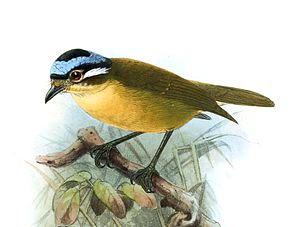Blue-cap flute
| Blue-cap flute | ||||||||||||
|---|---|---|---|---|---|---|---|---|---|---|---|---|

Blue-cap flute, drawing by John Gerrard Keulemans . |
||||||||||||
| Systematics | ||||||||||||
|
||||||||||||
| Scientific name of the family | ||||||||||||
| Ifritidae | ||||||||||||
| Schodde & Christidis , 2014 | ||||||||||||
| Scientific name of the genus | ||||||||||||
| Ifrita | ||||||||||||
| Rothschild , 1898 | ||||||||||||
| Scientific name of the species | ||||||||||||
| Ifrita kowaldi | ||||||||||||
| ( De Vis , 1890) |
The Blaukappenflöter ( Ifrita kowaldi , Syn. : Todopsis kowaldi ) is a bird art that in Bismarck Range on Guinea occurs. There are two subspecies: I. k. brunnea Rand , 1940 in the western part of the island and I. k. kowaldi from the central highlands in the middle and east, as well as on the Huon Peninsula .
features
The blue-cap flute becomes 16 to 17 cm long and weighs around 35 grams. The birds have a yellow-brown to ocher-colored back and a yellowish to light ocher-colored belly. It is named after the black, blue-lined head cap in the center. A narrow stripe behind the eyes is whitish in the males, light ocher in the females. I. k. brunnea differs from the nominate form in that it has a more brownish back and a slightly reddish-brown tint on the wings of the hand and the tail.
Habitat and way of life
The blue-capped flute occurs in moss-covered mountain forests at altitudes of 1460 to 3680 m, most of them live at altitudes between 2000 and 2900 meters. The birds feed on insects and sometimes also on soft fruits . The food is looked for both in the trees and on the ground. The skin and feathers of the blue cap flute can contain neurotoxic steroid alkaloids from the group of batrachotoxins . The toxins are probably absorbed with certain feed insects. In the trees, the Blaukappenflöter moves on the type of nuthatch ( Sitta europaea ), using his tail as a support and climbs even upside down in search of food. In doing so, he often joins other bird species. The blue-cap flute is likely to be relatively local. Nests with eggs were seen in September, nests with chicks in October and November, which means that the birds breed in the middle of the dry season and at its end. The nest is a large, thick-walled ball of moss and fern leaves , interwoven with tendrils and thin roots . One nest examined contained a single egg measuring 25.8 × 20.7 mm. It was sparsely patterned by black and dark purple spots. The pattern became thicker at the thick end of the egg. The blue-capped flute is considered safe.
Systematics
The blue-capped flute was described in 1890 by the British-Australian clergyman and zoologist Charles Walter De Vis . Its systematic position remained unclear for a long time. Today it is classified in an independent, monotypical family, the Ifritidae. This is probably the sister group of the monarchs (Monarchidae).
literature
- Boles, W. (2007). Blue-capped Ifrit ( Ifrita kowaldi ). In: del Hoyo, J., Elliott, A., Sargatal, J., Christie, DA & de Juana, E. (eds.) (2013). Handbook of the Birds of the World Alive. Lynx Edicions, Barcelona. (Retrieved from http://www.hbw.com/node/59740 on July 1, 2014).
Individual evidence
- ↑ JP Dumbacher, TF Spande & JW Daly: Batrachotoxin alkaloids from passerine birds: A second toxic bird genus (Ifrita kowaldi) from New Guinea. In: PNAS , Volume 97, Number 24, 2000, pp. 12970-12975, doi : 10.1073 / pnas.200346897 .
- ↑ Ifrita kowaldi in the endangered Red List species the IUCN 2008. Posted by: BirdLife International, 2016. Accessed on 09 December 2016th
- ↑ Schodde, R., and L. Christidis. 2014. Relicts from Tertiary Australasia: undescribed families and subfamilies of songbirds (Passeriformes) and their zoogeographic signal. Zootaxa 3786: 501-522. doi: 10.11646 / zootaxa.3786.5.1
- ↑ Jønsson, KA, PH. Fabre, JD Kennedy, BG Holt, MK Borregaard, C. Rahbek, and J. Fjeldså. 2016. A supermatrix phylogeny of corvoid passerine birds (Aves: Corvides) . Molec. Phylog. Evol. 94: 87-94.